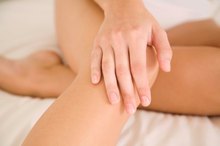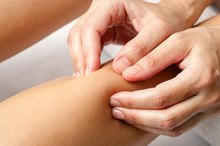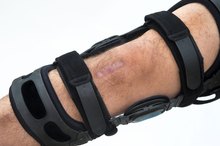Total Knee Replacement & Effect on Muscle Strength
The knee is the largest joint in the body. It is subject to wear and tear as the result of physical activity, obesity and certain autoimmune conditions such as rheumatoid arthritis. An orthopedic surgeon may suggest a total knee replacement when knee pain limits functional abilities such as climbing stairs and getting up from a chair. After surgery, the muscles surrounding the knee and hip become weak and require exercises prescribed by a physical therapist to improve functional performance and independence.
Knee Replacement Surgery
The knee joint is made up of three bones, the femur and tibia, which are the upper and lower leg bones, respectively, and the patella, or kneecap. A total knee replacement is surgery to remove damaged portions of those three bones and replace them with metal and plastic. A long vertical incision is made down the center of the knee, which is disruptive to the quadriceps muscles.
Quadriceps Weakness
Causes of Pain in the Upper Left Hip
Learn More
The quadriceps muscles are the thigh muscles above the knee and serve as the primary knee stabilizer. These muscles are weak after a total knee replacement because of the direct trauma from the surgical incision, but also because swelling in the joint signals muscle inhibition, or shutdown, as a protective mechanism. If the quadriceps muscles are not working correctly, it becomes difficult to lift the leg independently and walk without the use of an assistive device.
Hip Muscle Weakness
A study published in the February 2011 issue of "Physical Therapy" reports that improving hip muscle strength after a total knee replacement is crucial in returning to functional independence. Specifically, strengthening the hip abductors, or the muscles that bring the leg out to the side, will improve performance in stair climbing and transferring from a seated to standing position. These muscles also stabilize the hip while standing and play an important role in restoring a normal gait pattern.
Physical Therapy
How to Treat Muscles Pulled From Bones
Learn More
After a total knee replacement, physical therapy is important to improve the knee's range of motion and the lower extremity muscle strength. A major orthopedic surgery will globally affect the surrounding musculature, but the focus of therapy should be on the quadriceps and hip abductor muscle groups. Reduction of inflammation is another goal during the first few weeks after surgery to decrease pain and improve the performance of the quadriceps muscles. Follow a protocol outlined by a physician or physical therapist for exercises tailored to your specific deficits.
- After a total knee replacement, physical therapy is important to improve the knee's range of motion and the lower extremity muscle strength.
- A major orthopedic surgery will globally affect the surrounding musculature, but the focus of therapy should be on the quadriceps and hip abductor muscle groups.
Related Articles
References
- American Academy of Orthopaedic Surgeons: Total Knee Replacement
- "Physical Therapy"; Contribution of Hip Abductor Strength to Physical Function in Patients With Total Knee Arthroplasty; Sara Piva, et al.; February 2011
- "Journal of Orthopaedic and Sports Physical Therapy"; Total Knee Arthroplasty: Muscle Impairments, Functional Limitations, and Recommended Rehabilitation Approaches; W. Meier, et al.; May 2008
- Campi S, Tibrewal S, Cuthbert R, Tibrewal SB. Unicompartmental knee replacement - Current perspectives. J Clin Orthop Trauma. 2018;9(1):17-23. doi:10.1016/j.jcot.2017.11.013
- Lespasio MJ, Piuzzi NS, Husni ME, Muschler GF, Guarino A, Mont MA. Knee Osteoarthritis: A Primer. Perm J. 2017;21:16-183. doi:10.7812/TPP/16-183
Writer Bio
Mindy Riley began writing professionally in 2011 for LIVESTRONG.COM. She practices physical therapy in Evansville, Ind., with expertise in rehabilitation of the shoulder, knee and spine. Riley is a certified strength and conditioning specialist with the National Strength and Conditioning Association. She also has a Master of Physical Therapy from the University of Evansville.







